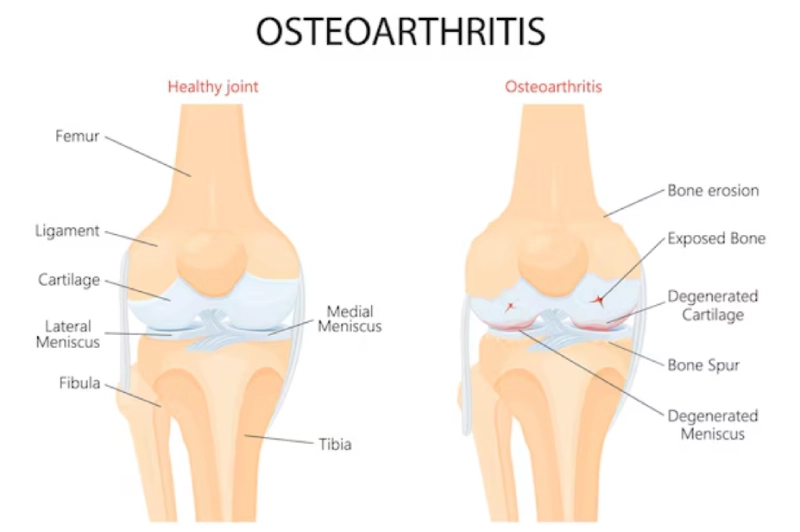The knee joint is formed from the upper end of the shinbone (tibia) and the lower end of the thighbone – femur and knee cap (patella). The ends of these three bones are covered with smooth slippery cartilage that cushions and protects your knee joint when you move, straighten, or bend your knees. The synovial membrane lining this joint releases a fluid that lubricates the cartilage and reduces friction.
Osteoarthritis of the knee
Between joints a natural cushioning cartilage is present. It acts just like a shock absorber. Over time this soft cartilage wears away resulting in a condition known as osteoarthritis. It is also known as wear-and-tear arthritis. When the cartilage wears away over time, the bones of the joint come closer and begin to rub against each other.
As the cartilage wears away and is lost, it becomes rough. When this happens, the space between the bones decreases resulting in bones rubbing against each other and the formation of painful bone spurs
Osteoarthritis usually develops slowly, and the pain it causes worsens over time.
The loss of cushioning results in friction as the bones rub and cause joint pain, swelling, stiffness, and diminished ability to move.
Most commonly osteoarthritis affects these joints: hands, knees, hips, and spine.
What are the signs and symptoms of Osteoarthritis of the knee?
Osteoarthritis is a progressively degenerative joint condition. The symptoms manifest slowly and worsen over time.
Joint pain is the most common symptom. It becomes severe with activity and movement.
Joint stiffness: easily observable after remaining inactive for some time or waking up from sleep.
Swelling: mostly seen around the joint due to soft tissue inflammation.
Popping or crackling sound or grating sensation while moving the knee joint
Restricted movement and loss of flexibility in the knee joint.
Difficulty in moving the joint through a full range of motion.
Tenderness: when you apply light pressure, you can feel it.
Who gets osteoarthritis of the knee joint?
This type of arthritis is common. Young people too can get it, but the risk most likely increases after age 45 and in older people. Compared to men women are more likely to get this condition.
What are the risk factors for osteoarthritis of the knee joint?
Age is the most common risk factor for osteoarthritis. There is some degree of risk for osteoarthritis for all with advancing age. However, excess body weight; family history due to hereditary predisposition; gender (being women), and repetitive stress injuries can increase the risk manifolds.
People who are involved in long-distance running, tennis, soccer, and hockey are at higher risk for osteoarthritis.
Rheumatoid arthritis, certain metabolic disorders, excess growth hormone or iron overload can also increase the risk.
What should you do to manage osteoarthritis symptoms?
Although the damage caused to your joints cannot be reversed, you can manage the symptoms. To minimize the effects of arthritis on your joints, you should remain active, maintain a healthy body weight, and do some physical exercise and activities under the supervision of an experienced physiotherapist. This will help slow down the progress of osteoarthritis and help improve joint mobility and function by reducing pain.
How is arthritis diagnosed?
Your orthopedic doctor examines you physically to look for tenderness, swelling, redness, or warmth in your joint. The doctor will also see whether you have any joint instability; pain while bearing weight; any injury or problems with movement. The doctor will also see whether you have any grating sensation with joint movement.
After a physical examination, your orthopedic doctor may order X-rays and other imaging tests.
Treatment for Arthritis
Your doctor initially recommends non-surgical treatment based on the severity of your condition – mostly when it is mild to moderate. Your orthopedic doctor will recommend:
- Lifestyle modifications: weight reduction, involvement in low-impact activities such as swimming or cycling.
- Minimizing activities such as climbing stairs, and high-impact activities such as tennis, jogging, and other sports.
- Physical therapy to help improve flexibility and a range of motions
- Assistive devices such as supportive or unloader braces, use of a cane, or wearing plastic bandages.
- Over-the-counter medications or cortisone injections.
Surgical Treatment
Your doctor may recommend surgery if your pain from arthritis causes disability and is not relieved with nonsurgical treatment. There are different surgical procedures and techniques based on the severity of your condition. It is better to consult your orthopedic doctor to know which is the best procedure in your case.


